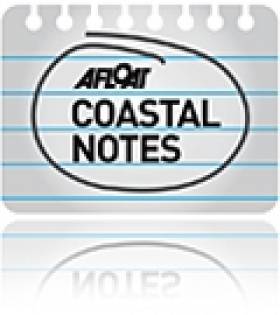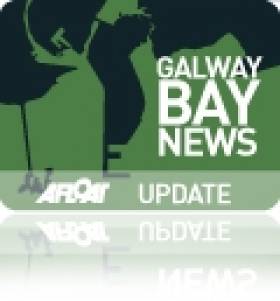Displaying items by tag: Coastal Notes
Coastal Community Cut Off By Cliff Collapse
#CoastalNotes - Heavy rains last week caused the latest in a series of landslides that has cut off a coastal village in Co Kerry, as TheJournal.ie reports.
Only pedestrian access is currently permitted on the Cliff Road to Rossbeigh after a partial collapse of the roadside into the sea on Thursday (17 September).
But the cliff fall is no surprise to locals who have complained for the last two years over increasing erosion caused by various heavy rains and severe storms.
TheJournal.ie has more on the story HERE.
South Coast Attractions Get Funding As Part Of 'Ireland's Ancient East'
#CoastalNotes - Two tourist attractions on the south coast will receive funding under the Government's new 'Ireland's Ancient East' initiative.
Cobh's Titanic Connections attraction and guided tours of Hook Lighthouse in Co Wexford are among 12 projects that will share in €1.2 million of funding made available by Minister for Tourism Pascal Donohoe, as TheJournal.ie reports.
Other attractions benefiting from the windfall include Boyne Valley: Waterway Through Time in Trim, Co Meath.
And a further €600,000 will go towards branded signage for the initiative which aims to be an east coast rival to the successful Wild Atlantic Way.
TheJournal.ie has more on the story HERE.
Man Faints On Newly Reopened Gobbins Cliff Path
#CoastalNotes - Emergency services rushed to the aid of an elderly man who fainted on the new cliff walk at The Gobbins in Co Antrim on Thursday (3 September).
As BelfastLive reports, the 79-year-old collapsed half-way along the "white-knuckle" coastal path that recently welcomed its 1,000th visitor since reopening last month for the first time since the 1950s.
The path was closed during the incident as the man recovered enough to walk away with the aid of council staff and local fire fighters. He was subsequently pronounced fit and healthy by paramedics at a waiting ambulance.
Mid and East Antrim Council has warned that the dizzying Gobbins path requires a reasonable level of fitness to traverse its series of rugged steps, tunnels, caves and tubular bridges that are not for the faint-hearted.
'Suspicious Object' Retrieved By NI Beach Lifeguards
#Portrush - RNLI lifeguards on Northern Ireland's north coast who spotted a suspicious object in the sea on Thursday afternoon (2 July) recovered an old sofa that had been dumped in the water.
Senior lifeguard Bosco McAuley and lifeguards Bruce and Shane Traill were patrolling Whiterocks Beach in Portrush around 2pm on Thursday when they spotted something in the water 150m from the shore.
The lifeguards, who couldn’t tell what was in the water using their binoculars, immediately launched their rescue water craft and made their way to the scene to investigate.
Weather conditions at the time were very good as around 200 people were enjoying the sunshine on the beach.
The lifeguards soon discovered that the object was an old sofa which had been dumped into the sea. On recovering the item out of the water and away from public harm, the lifeguards proceeded to put the sofa on one of their trucks and safely disposed of it.
"While on one hand it might appear quite funny that we launched and recovered an old sofa from the sea, it is important to point out that our lifeguards, who are highly skilled and trained, acted in good faith responding swiftly when they noticed something unusual in the water," said RNLI lifeguard supervisor Tim Doran.
"We would always encourage visitors to the beach to alert us or phone the coastguard should they notice anything suspicious. We would always rather investigate the incident to find it is a sofa and all is well than not know and then discover too late that someone is in difficulty."
Doran added: "Our lifeguards will deal with a variety of incidents over the summer period and while I hope this will be one of the fewer types of instances, it does highlight the vigilance they show to keep our beaches safe."
Benone Strand Lifeguard Unit Vandalised Twice In A Week
#Benone - The RNLI beach lifeguard unit on Benone Strand on the North coast has been vandalised for a second time in a week.
During what is traditionally one of the RNLI lifeguard’s busiest weeks of the year, the charity’s lifeguards discovered on Wednesday morning (1 July) that vandals had damaged the exterior of the beach lifeguard unit for a second time within a week.
The railings around the exterior of the hut had been badly bent, a ventilation fan on the roof of the unit had been broken off, and fencing leading up to the unit that protects the surrounding dune system had also been broken.
The RNLI are working closely with the PSNI in an attempt to prevent further damage being done to the beach unit throughout the summer.
"It is estimated that repairs to the beach lifeguard unit will run into hundreds of pounds for the charity, as the railings, fencing and ventilation fan will have to replaced and fitted," said RNLI lifeguard supervisor Tim Doran.
"While our lifeguards are on duty many people come up to the units for assistance and advice and they are easily identifiable. We hope that these acts of vandalism will cease and that our lifeguards can continue to operate from them safely when carrying out their lifesaving work."
#CoastalNotes - Doolin expects to double the number of visitors on its ferry route to the Aran Islands after the opening of its new €6m pier last week.
As the Irish Examiner reports, it's envisaged up to 200,000 people will use the Co Clare village as a gateway to the Galway Bay island chain via the new pier which does away with the former practice of 'trans-shipping', or ferrying passengers by currach from the older, smaller pier to the ferry offshore at low tide.
Among the locals hailing the new pier's potential for the locality is ferry operator Eugene Garrihy, who says it represents "the best money spent here in decades" and believes the investment "will double within the next three to five years" as the previously announced master plan is carried out.
Garrihy adds that the ferry route was "completely hamstrung in the past by tidal issues, which prevented us [ferry operators] from scheduling sailings for a peak period of the day, but now the pier is redeveloped the shackles are definitely off for us.”
He also said that despite opposition from surfers over the pier's feared impact on the Crab Island wave, they have benefitted from the project in the form of a shower block and new launch area.
The Irish Examiner has more on the story HERE.
Bathing Warnings At Youghal Beach For Rest Of Summer Season
#CoastalNotes - 'Poor' water quality off Youghal have seen the Cork town's beach subject to bathing advisories for the remainder of the summer season, as the Irish Examiner reports.
Stricter EU regulations on bathing water quality have prompted Cork County Council to erect notices advising against swimming at the popular Front Strand till at least 15 September.
Regular testing will be carried out in the meantime at the beach, which suffers more than others in the area due to runoff from farms along the River Blackwater which enters the sea nearby.
Youghal has long been identified as a pollution blackspot on the Irish coast, being one of a number of urban areas still discharging untreated wastewater into the sea.
The Irish Examiner has more on the story HERE.
#MaritimeART – The Port of Cork Maritime Collection is to be hosted by the Bantry Bay Port Company writes the West Cork Times.
The exhibition of maritime themed paintings and models is now open at Bantry House, West Cork.
Visitors to the exhibition (which runs until 28th June), will showcase a selection of the Port's historic maritime art pieces dating back from the 1800s.
Highlights of the collection include a number of paintings by marine artist George Mounsey Wheatley Atkinson and Robert Lowe Stopford who is known for his series of panoramic views of Queenstown.
This exhibition offers the public a chance to view this one of a kind collection of paintings which is usually housed in the Port's headquarters in Custom House.
For more on this story, click here.
#CoastalNotes - The video above is not a coastal distress flare, but a 'fireball' from space burning up as it enters the atmosphere far above Ireland.
A flurry of reports from concerned members of the public received by the Irish Coast Guard have been traced to the meteorite that streaked across the sky on Sunday night (April 26).
The Irish Mirror has more on the spectacular phenomenon that lit up the whole country for a few seconds shortly after 10pm on Sunday.
And as David Moore of Astronomy Ireland says, it was so bright that it's likely part of the space rock survived re-entry and might be found intact somewhere on land or shore.
Consultation Planned For Galway Bay Coastal Walkway
#GalwayBay - Galway City Council will soon open a public consultation on a proposed new walkway between Salthill and Silverstrand, as the Galway Advertiser reports.
The new Galway Bay coastal walking route will comprise a series of "scenic pathways and footbridges spanning the shoreline" between the Salthill Promenade and the beach at Silverstand in Barna two miles to the west.
And the €7 million project also involved works to protect from coastal erosion, which will speed up the foreshore licence application process once the views of the pubic have been sought.
The Galway Advertiser has more on the story HERE.































































